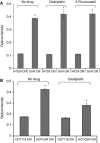Chemoresistant colorectal cancer cells and cancer stem cells mediate growth and survival of bystander cells
- PMID: 22045189
- PMCID: PMC3242606
- DOI: 10.1038/bjc.2011.449
Chemoresistant colorectal cancer cells and cancer stem cells mediate growth and survival of bystander cells
Abstract
Background: Recent studies suggest that cancer stem cells (CSCs) mediate chemoresistance, but interestingly, only a small percentage of cells in a resistant tumour are CSCs; this suggests that non-CSCs survive by other means. We hypothesised that chemoresistant colorectal cancer (CRC) cells generate soluble factors that enhance survival of chemonaive tumour cells.
Methods: Chemoresistant CRC cells were generated by serial passage in oxaliplatin (Ox cells). Conditioned media (CM) was collected from parental and oxaliplatin-resistant (OxR) cells. CRC cells were treated with CM and growth and survival were assessed. Tumour growth rates were determined in nude mice after cells were treated with CM. Mass spectrometry (MS) identified proteins in CM. Reverse phase protein microarray assays determined signalling effects of CM in parental cells.
Results: Oxaliplatin-resistant CM increased survival of chemo-naive cells. CSC CM also increased growth of parental cells. Parental and OxR mixed tumours grew larger than tumours composed of parental or OxR cells alone. Mass spectrometry detected unique survival-promoting factors in OxR CM compared with parental CM. Cells treated with OxR CM demonstrated early phosphorylation of EGFR and MEK1, with later upregulation of total Akt .We identified progranulin as a potential mediator of chemoresistance.
Conclusion: Chemoresistant tumour cells and CSCs may promote resistance through soluble factors that mediate survival in otherwise chemosensitive tumour cells.
Figures





References
-
- Barker N, Ridgway RA, van Es JH, van de Wetering M, Begthel H, van den Born M, Danenberg E, Clarke AR, Sansom OJ, Clevers H (2009) Crypt stem cells as the cells-of-origin of intestinal cancer. Nature 457: 608–611 - PubMed
-
- Beatty GL, Giantonio BJ (2008) Bevacizumab and oxaliplatin-based chemotherapy in metastatic colorectal cancer. Expert Rev Anticancer Ther 8: 683–688 - PubMed
-
- Bhushan S, McLeod H, Walko CM (2009) Role of pharmacogenetics as predictive biomarkers of response and/or toxicity in the treatment of colorectal cancer. Clin Colorectal Cancer 8: 15–21 - PubMed
-
- Blazer III DG, Kishi Y, Maru DM, Kopetz S, Chun YS, Overman MJ, Fogelman D, Eng C, Chang DZ, Wang H, Zorzi D, Ribero D, Ellis LM, Glover KY, Wolff RA, Curley SA, Abdalla EK, Vauthey JN (2008) Pathologic response to preoperative chemotherapy: a new outcome end point after resection of hepatic colorectal metastases. J Clin Oncol 26: 5344–5351 - PubMed
Publication types
MeSH terms
Substances
Grants and funding
LinkOut - more resources
Full Text Sources
Other Literature Sources
Medical
Research Materials
Miscellaneous

